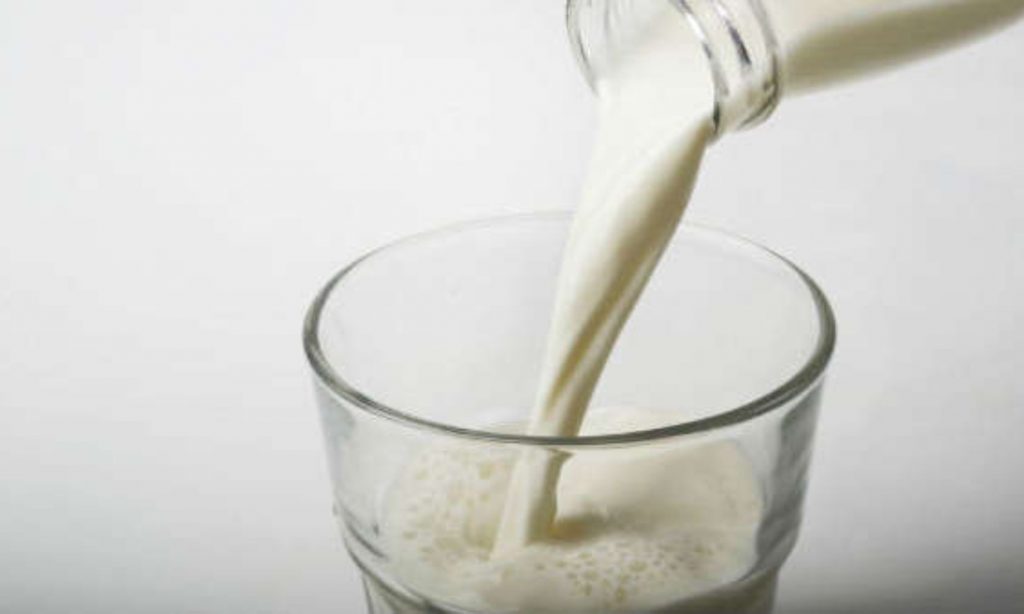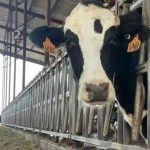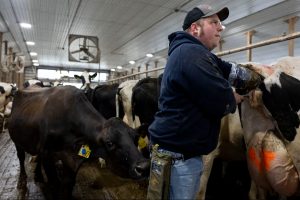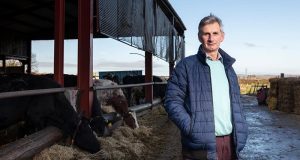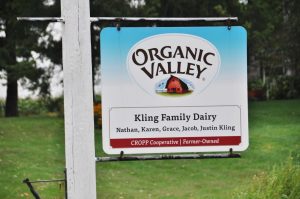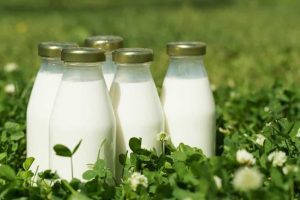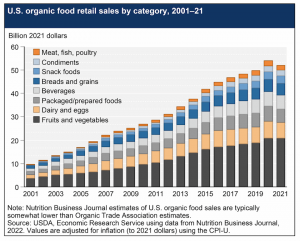“Most organic dairies average one and a half acres per cow, and the cost of land is increasing every year. The extra cost here is either in debt payment or the ability to have less cows,” Ed Maltby, Executive Director of Northeast Organic Dairy Producers Alliance, tells me by email.
How much does it cost to feed cows?
Making sure cows are fed 100% certified organic food is another big expense for organic dairy farms. While at least 30% of the cows’ diet must come from pasture which must adhere to USDA-certified organic farming guidelines, organic grain feed can cost as much as 50% more than conventional grain feed for cattle. This is typically composed of organically grown soybeans, corn, field peas, oats, and other grains. And its price can fluctuate due to global market supply issues far beyond the dairy farmers’ control—for instance, says Mendenhall, domestic organic soybean prices are high right now because some of the cheaper imported organic soybeans from India which had previously flooded the market were found to be fraudulent. Those price hikes get passed onto the farmers. (In this instance, Mendenhall says this may be a good change in the long run, as increased demand for organic soybean production may push the domestic market forward.)
Still, for the time being, organic soybean meal has more than doubled in price, from $632 per ton in 2020 to $1,900 per ton in 2022, writes Maltby. That’s not the only cost that’s been rising: the cost of fuel—which has by some estimates increased by up to 75% in 2022—has also been hard on dairy producers as well as all industries that transport goods. Organic farmers must also feed baby cows milk rather than formula, leaving the calves to nurse longer and using up some of their milk supply on feeding calves.
Then there’s drought, which has been affecting agriculture including dairy production—organic and conventional, and from coast to coast—for the last several years. Hay will typically balance out an organic dairy cow’s winter diet when grazing is not an option. But the cost of hay can skyrocket during drought, such as it did this summer in places like Texas and Nebraska. And the Western United States is facing the worst drought in 1,200 years.
“That’s causing organic dairies’ feed costs to go up 25–30%—half their income goes to feed, says Albert Straus, founder of Straus Family Creamery in Sonoma County, California, in a phone call. His family has had a dairy farm in the region since 1941, which he converted to organic in 1994, the same year he founded the all-organic creamery. “So organic dairies expect to lose an average of $250,000 this year,” says Straus.
Other costs unique to organic dairy farmers versus conventional simply go to record-keeping in order to uphold their certification status—which can be burdensome for a small family business. That’s why some farmers don’t even seek official USDA organic certification, even if they may go above and beyond the guidelines in practice.
How does this all affect what’s in the actual carton?
Those regulated diets that organic dairy cows eat promote their own health, and that’s reflected in the dairy products they produce. Cows can produce more milk if they’re fed higher-energy feed like corn, but that doesn’t induce a good, healthy cow gut, says Mendenhall. A diverse diet of grasses, clovers, alfalfa, and other plants naturally found in pasture feeds more diverse and beneficial nutrients into the milk they produce. Studies have found milk from grass-fed cows to be higher in phytonutrients, as well as higher in omega-3 fatty acids, which can have a positive impact on heart health.
“The cows are typically healthier, their gut is healthier, and the nutrients going into the milk is healthier for you,” says Mendenhall of pastured cows. (It should be mentioned that milk labeled “grass-fed” or “grassmilk” has even stricter dietary guidelines for its cows, stipulating a 100% forage-based diet; it is also typically even more expensive than organic milk.)
You can see and taste the difference, too. The milk of pastured cows is not typically white, although its color may vary depending on the season. Beta-carotene from a grassy cow diet will imbue the milk with a creamy yellow hue.
“Our butter is yellow, low in moisture, high in fat, and it’s very rich in beta-carotene from the pastures and the feeds,” says Straus. “The milk has a body and flavor that really reflects the flavor of milk that I grew up on—the raw milk that comes straight from the cows.”
It also reflects the environment, thanks to the coastal grasses its cows are fed, says Straus. Milk terroir is real.
Then there’s the stuff that organic milk doesn’t have by prohibiting the uses of antibiotics, chemical pesticides, and bovine growth hormones. A 2019 study conducted by Emory University and published by the Cambridge University Press found all of the above in samples of non-organic milk in the US. Antibiotic residue, including some antibiotics that are banned for dairy cattle by the FDA, was detected in 60% of conventional milk samples but not in the organic milk, according to the study. Antibiotic resistance due to overuse in the agriculture industry is a global threat to human health and our entire ecosystem. Pesticide residue found in conventional milk is another concern; the Emory study found low levels of several chemicals present, such as atrazine, which the EPA has warned has been linked to certain cancers and birth defects.
The effect of bovine growth hormone residue on human health is more speculative. All cows naturally produce hormones. But starting in the 1990s, a synthetic chemical called recombinant bovine growth hormone or rBGH was developed to increase milk production in dairy cows. This dovetailed with studies that found puberty starting sooner in American girls, leading to widespread speculation as to the cause. While a connection to drinking rBGH via milk has been largely dismissed, artificial growth hormones are still banned for use in organic dairy production, and even many conventional producers advertise “no added hormones” in their products as well.
The hormone controversy aside, the practices maintained through organic dairy farming are there to ensure a healthier product—and a healthier environment. Proponents say that when cows are allowed to move around outdoors, fed a diet that include the grass that they evolved to consume, and are not dosed with antibiotics or growth hormones for production, they are healthier and live longer lives. Raised on land that is well-maintained, without overcrowding that can contaminate waterways, wells and soil, they can play a role in a diversified, regenerative farming system. This is, ultimately, the impetus behind the organic farming labeling requirements, whether in dairy or other types of agriculture.
Of course, there are arguments to be made for not consuming dairy or meat at all. Currently, cattle (whether from dairy or meat farms) are the leading source of methane emissions in the US. And as we’ve explored, producing dairy in an environmentally responsible way is not easy nor cheap. All dairy farms are suffering from inflation-related challenges, and the higher price tag makes organic milk a lot less accessible for those who may want to support these farming practices (and makes alternatives like oat milk look a lot more appealing). But the next time you’re standing in that chilly refrigerator aisle comparing prices, know that your money is going toward maintaining higher ethical standards—and nutritional benefits—when you’re paying for organic milk. It’s something these producers have bet the farm on.

